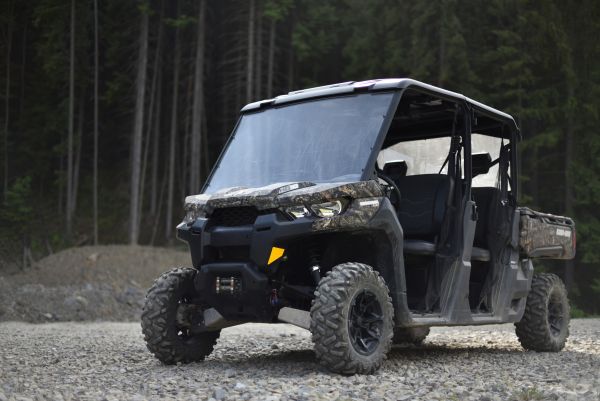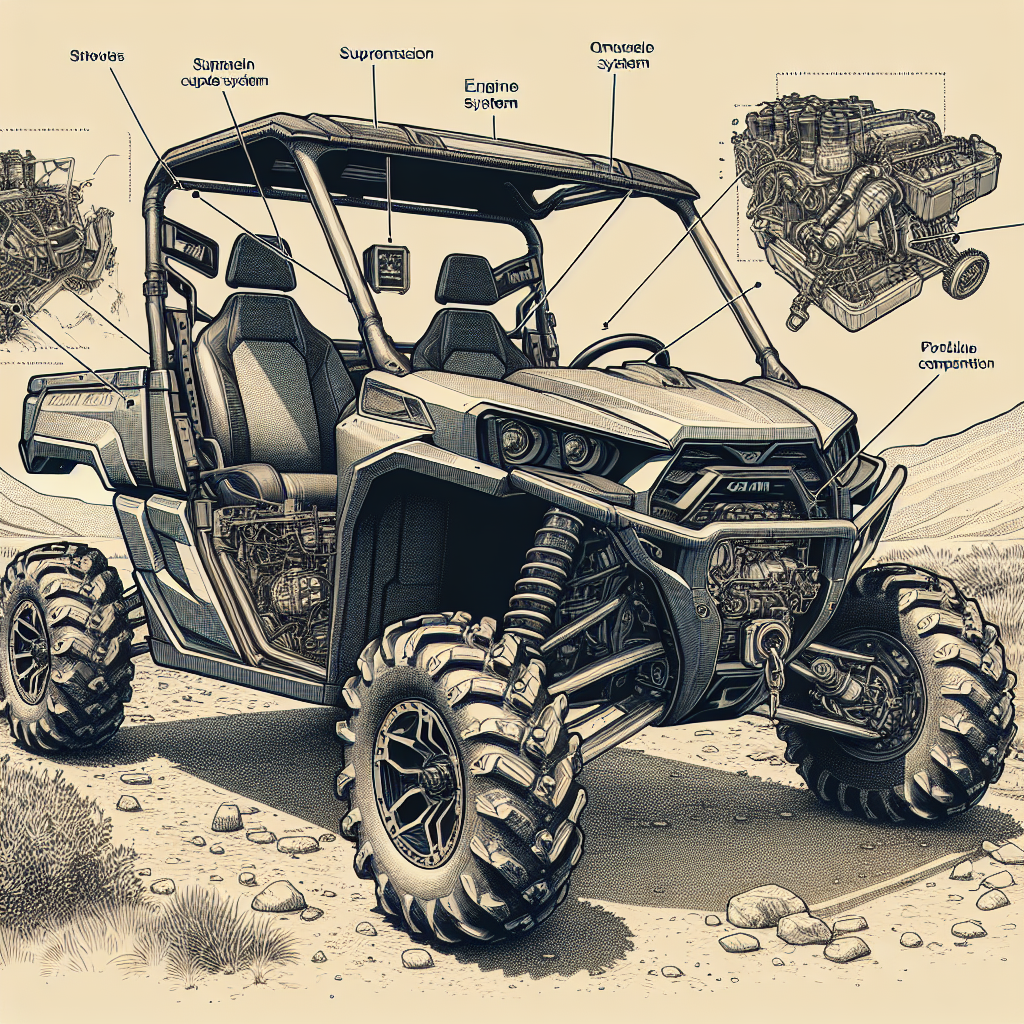The Can-Am Defender is a popular side-by-side vehicle that is known for its ruggedness, versatility, and comfort. However, some owners have reported issues with the air conditioning system, which can make for an uncomfortable ride in hot weather. In this article, we will explore some of the common Can-Am Defender AC problems and how they can be resolved.

One of the most common issues with the Can-Am Defender AC system is a failure to cool the cabin adequately. This can be caused by a variety of factors, including low refrigerant levels, a faulty compressor, or a clogged condenser. If you notice that your AC is not blowing cold air, it is important to have it inspected by a qualified technician to determine the root cause of the problem.
Another issue that some owners have reported is a flashing icon next to the temperature setting on the control panel. This icon indicates that there is a fault in the AC system, and it may cause the system to stop working altogether. Again, it is important to have the system inspected by a technician to identify the underlying problem and make any necessary repairs.
Related reads:
– Can-am Defender Front Differential Problems (+Fixes)
– Can-am Defender Clutch Problems: Tips, Tricks, and More
Understanding Can-Am Defender AC System
Components and Functionality
The Can-Am Defender AC system is composed of several components that work together to provide cool air to the cabin. It includes a compressor, condenser, evaporator, expansion valve, and refrigerant lines. The compressor is responsible for compressing the refrigerant gas, which then flows through the condenser to release heat. The cooled refrigerant then moves to the evaporator, where it absorbs heat from the cabin air and cools it down. The expansion valve regulates the flow of refrigerant, and the refrigerant lines connect all the components.
The AC system also has an HVAC system that controls the airflow and temperature. The HVAC system includes a blower motor, air ducts, and vents that distribute the cool air throughout the cabin. The air conditioning system works by removing heat and humidity from the air, which makes it more comfortable for the passengers.
Common AC Issues in Can-Am Defender
There are several common issues that Can-Am Defender owners may encounter with their AC system. One of the most common problems is a leak in the refrigerant lines or the evaporator. This can cause the AC system to stop working or produce warm air. Another common issue is a faulty compressor clutch or AC pressure switch, which can prevent the compressor from engaging and producing cool air.
Other issues that can affect the AC system include clogged air filters, malfunctioning blower motors, and damaged condenser or evaporator coils. These problems can reduce the efficiency of the AC system and make it harder to cool down the cabin.
Maintenance Tips for AC System
To keep the AC system in good condition, it’s essential to perform regular maintenance. This includes checking the refrigerant level, inspecting the refrigerant lines for leaks, and cleaning or replacing the air filters. It’s also important to check the compressor clutch and AC pressure switch for proper operation and to ensure that the blower motor is working correctly.
Additionally, it’s recommended to have the AC system serviced by a qualified technician every two years or as recommended by the manufacturer. Regular maintenance can help prevent AC problems and ensure that the system is working efficiently to provide cool air to the cabin.
Troubleshooting and Repairs
Diagnosing AC Problems
When the AC system in a Can-Am Defender is not working, it can be due to a variety of issues. The first step in diagnosing the problem is to check the fuse box. If the fuse is blown, it needs to be replaced. If the fuse is not the issue, then the problem may be due to overheating, clogs, dirt, or damage to the system.
The next step is to check the coolant level. If the coolant level is low, then the AC system may not work properly. It is also important to check the wires and connections to ensure that they are not damaged or loose. If the wires or connections are damaged or loose, then they need to be repaired or replaced.
Another common issue that can cause problems with the AC system is a malfunctioning radiator or thermostat. If the radiator is damaged or clogged, then it can prevent the AC system from working properly. Similarly, if the thermostat is malfunctioning, then it can cause the AC system to malfunction.
Effective Solutions for AC Issues
If the AC system in a Can-Am Defender is not working properly, there are several effective solutions that can be used to fix the problem. One of the most common solutions is to recharge the refrigerant in the system. This can be done by a mechanic or the dealer.
Another effective solution is to replace the gaskets in the system. If the gaskets are worn or damaged, then they can cause leaks in the system, which can prevent the AC from working properly. It is also important to clean the system regularly to prevent clogs and dirt buildup.
When to Contact a Dealer or Mechanic
If the AC system in a Can-Am Defender is not working properly, and the above solutions do not work, then it is important to contact a dealer or mechanic. They will be able to diagnose the problem and provide effective solutions. It is also important to contact a dealer or mechanic if the system is damaged or if any components need to be replaced.
Can-Am Defender Design and Impact on AC Performance

Vehicle Design Considerations
The Can-Am Defender is a versatile off-road vehicle designed to tackle tough terrains and harsh conditions. The vehicle’s design is intended to provide maximum protection to its occupants and components while ensuring optimal performance. The Defender’s body is made of high-strength steel, which provides excellent durability and resistance to damage from impacts, debris, and rust.
The Defender’s design also includes several features that contribute to its performance and functionality. For instance, the vehicle has ample storage space for carrying gear and accessories, making it an ideal choice for outdoor enthusiasts. The Defender’s towing capacity is also impressive, allowing it to haul heavy loads with ease. Additionally, the vehicle’s ground clearance and suspension system are designed to provide excellent off-road capability, ensuring a comfortable ride on rough terrain.
Impact of Off-Road Conditions
Off-road conditions can have a significant impact on the performance of the Can-Am Defender’s AC system. The vehicle’s AC system is designed to provide cool air to the occupants, but it can be compromised by dust, mud, and debris. The Defender’s design includes several features that help to protect the AC system from these elements.
For instance, the vehicle’s air intake is located high up on the vehicle’s body, reducing the amount of dust and debris that can enter the system. The Defender’s cabin air filter is also designed to trap dust and other particles, ensuring that the AC system remains clean and functional. The vehicle’s body design includes several features that help to prevent rust and corrosion, which can also impact the performance of the AC system.
In conclusion, the Can-Am Defender’s design plays a crucial role in the performance of its AC system. The vehicle’s robust construction, ample storage space, towing capacity, ground clearance, and suspension system all contribute to its off-road capability and overall functionality. The Defender’s design also includes several features that help to protect the AC system from the impact of off-road conditions, ensuring that occupants remain comfortable even in harsh environments.
Preventive Measures and Long-Term Care

Regular Maintenance Schedule
To prevent AC problems and ensure a comfortable ride, regular maintenance is crucial. It is recommended to follow the manufacturer’s maintenance schedule and perform routine checks on the UTV’s AC system. This includes inspecting the air filter, ducts, and cooling fan for blockages or corrosion.
Moreover, it is important to check the AC belt for wear and tear and replace it if necessary. Neglecting to replace a worn-out belt can cause steering issues and engine overheating, which can ultimately lead to AC problems.
Protecting AC System from Common Off-Road Hazards
Off-road hazards such as dust, dirt, and water can cause damage to the AC system. To protect the system, it is recommended to install a snorkel kit to elevate the air intake and prevent water from entering the system. Additionally, a pre-filter can be added to the air intake to prevent dust and dirt from entering the system.
Regularly inspecting the AC system for signs of corrosion and cleaning the connectors on the AC switches can also prevent AC problems. Lastly, checking the water pump for proper functioning and ensuring that the coolant level is sufficient can prevent the AC system from overheating.
By following these preventive measures and performing regular maintenance checks, Can-Am Defender owners can avoid AC problems and enjoy a comfortable ride.
Frequently Asked Questions

What are typical symptoms of AC issues in a Can-Am Defender?
If your Can-Am Defender’s air conditioning system is not working correctly, you may notice some common symptoms. Some of the most typical symptoms include weak airflow, warm air blowing from the vents, strange noises coming from the system, and a musty smell. If you notice any of these symptoms, it may be time to have your Can-Am Defender’s AC system inspected.
How can I recharge the air conditioning system in a Can-Am Defender?
Recharging the air conditioning system in a Can-Am Defender is a relatively straightforward process. First, you will need to locate the low-pressure service port on the AC system. Then, connect the recharge kit to the service port and add refrigerant until the correct pressure is reached. It’s essential to follow the manufacturer’s instructions and use the correct type of refrigerant for your Can-Am Defender.
What steps should I take to troubleshoot air conditioning malfunctions in a Can-Am Defender?
If you’re experiencing issues with your Can-Am Defender’s air conditioning system, there are a few steps you can take to troubleshoot the problem. First, check the fuses and relays associated with the AC system. Next, inspect the AC compressor, condenser, and evaporator for signs of damage or wear. Finally, check the AC pressure switch and ensure that the refrigerant level is correct.
How do I locate and check the AC pressure switch in a Can-Am Defender?
The AC pressure switch in a Can-Am Defender is typically located on the high-pressure side of the AC system. To check the switch, you will need to use a multimeter to test for continuity. If the switch is faulty, it will need to be replaced.
What is the freon capacity for a 2021 Can-Am Defender’s AC system?
The freon capacity for a 2021 Can-Am Defender’s AC system is typically around 1.15 pounds of refrigerant. It’s essential to use the correct type of refrigerant and not overfill the system.
How can I resolve drainage problems with my Can-Am Defender’s air conditioning unit?
If your Can-Am Defender’s air conditioning unit is not draining correctly, it may be due to a clogged drain line or evaporator. To resolve the issue, you will need to locate and clean the drain line. If the problem persists, it may be necessary to have the evaporator inspected and cleaned by a professional.


